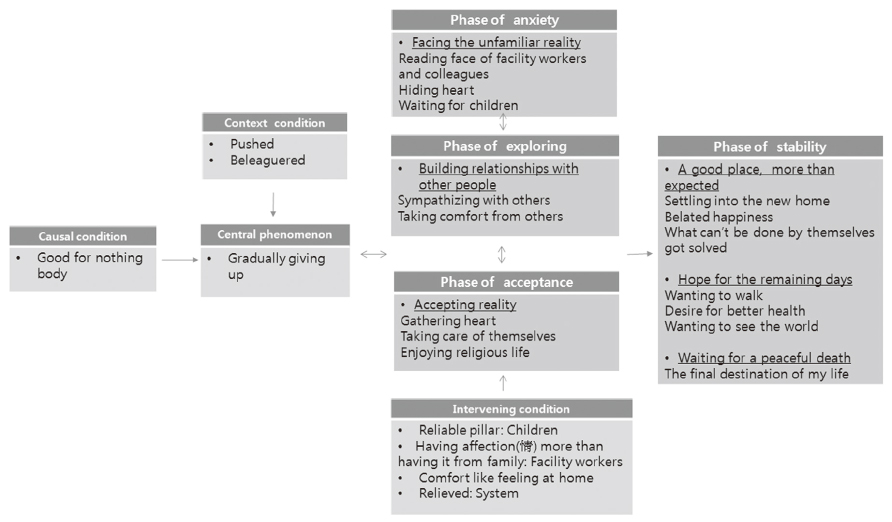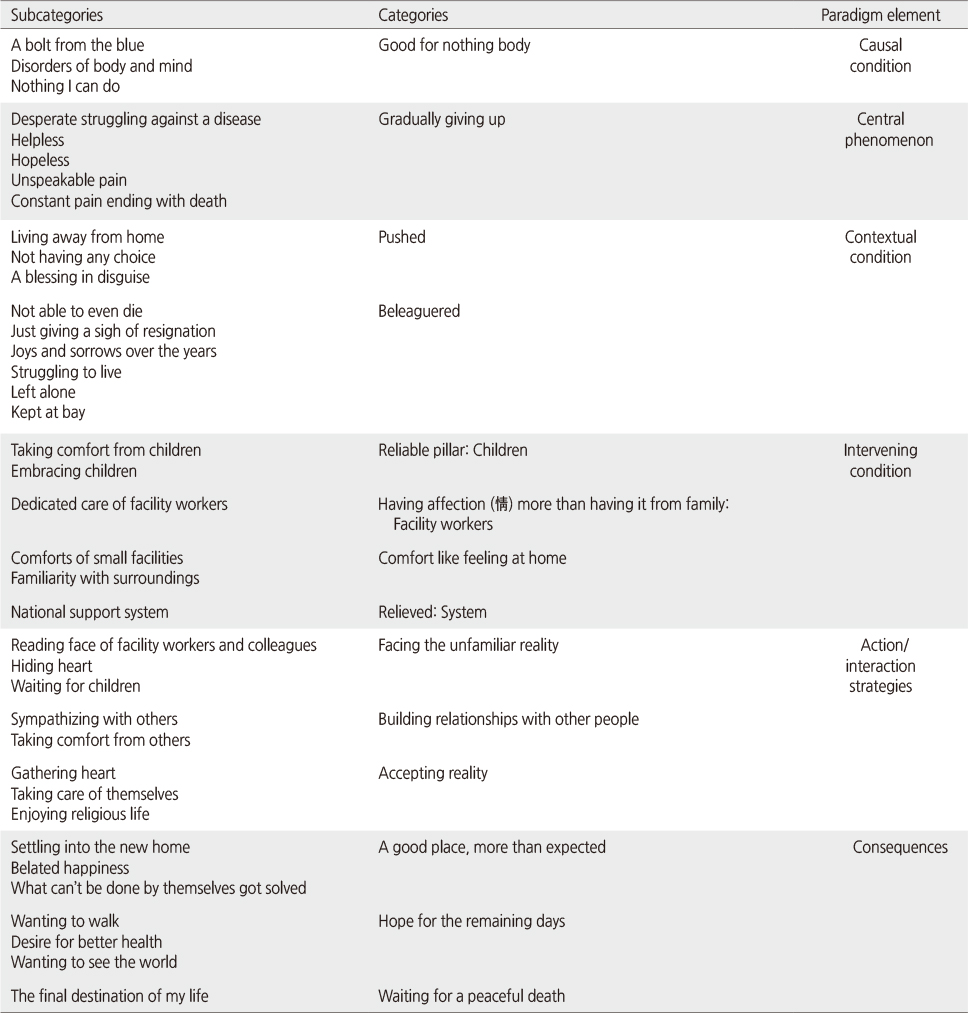Articles
- Page Path
- HOME > J Korean Acad Nurs > Volume 46(6); 2016 > Article
-
Original Article
- Adaptation Process to Group Home Living by Older Adults
- Hee Sook Yoon, Sohyune Sok
-
Journal of Korean Academy of Nursing 2016;46(6):858-870.
DOI: https://doi.org/10.4040/jkan.2016.46.6.858
Published online: December 30, 2016
1Department of Medical Welfare, Kyung Bok University, Namyangju, Korea.
2College of Nursing Science, Kyung Hee University, Seoul, Korea.
- Address reprint requests to: Sok, Sohyune. College of Nursing Science, Kyung Hee University, 26, Kyungheedae-ro, Dongdaemun-gu, Seoul 02447, Korea. Tel: +82-2-961-9144, Fax: +82-2-961-9398, 5977sok@khu.ac.kr
• Received: February 29, 2016 • Revised: October 26, 2016 • Accepted: November 1, 2016
© 2016 Korean Society of Nursing Science
This is an Open Access article distributed under the terms of the Creative Commons Attribution NoDerivs License. (http://creativecommons.org/licenses/by-nd/4.0/) If the original work is properly cited and retained without any modification or reproduction, it can be used and re-distributed in any format and medium.
Abstract
-
Purpose
- The purpose of the study was to explore and describe the adaptation process of older people to group homes.
-
Methods
- Participants were twenty older adults aged 65 or older who were living in group homes. Data were collected from January to April, 2015. In-depth unstructured interviews were conducted with individual participants. Data were analyzed using Strauss and Corbin's grounded theory method.
-
Results
- From open coding, 100 concepts, 38 sub-categories, and 14 categories were identified. Analysis showed that the central phenomenon of the adaptation process of older people to group homes was ‘gradually giving up’. Causal conditions were ‘good-for-nothing body’, contextual conditions were ‘pushed’, ‘beleaguered’. Intervening conditions were ‘reliable pillar: children’, ‘having affection (情) more than having it from family: facility workers’, ‘comfort - like feeling at home’, ‘relieved: system’. Action/interaction strategies were ‘facing the unfamiliar reality’, ‘building relationships with other people’, ‘accepting reality’. Consequences were ‘a good place, more than expected’, ‘hope for the remaining days’, ‘waiting for a peaceful death’.
-
Conclusion
- The results of this study provide an in-depth understanding of the experience of the adaptation process of older people to group homes. The findings from this study can be used as basic data to establish policies to increase the number of small scale facilities which can help older adults adapt easily to the facilities.
- 1. Ministry of Health and Welfare. 2015 Elderly welfare facilities status [Internet]. Sejong, Author. 2015;cited 2015 January 3. Available from:http://www.mohw.go.kr/front_new/jb/sjb030301vw.jsp?PAR_MENU_ID=03&MENU_ID=0321&CONT_SEQ=324013&page=1
- 2. Heliker D, Scholler-Jaquish A. Transition of new residents to long-term care: Basing practice on residents’ perspective. J Gerontol Nurs. 2006;32(9):34–42.Article
- 3. Iwasiw C, Goldenberg D, Bol N, MacMaster E. Resident and family perspectives. The first year in a long-term care facility. J Gerontol Nurs. 2003;29(1):45–54. Article
- 4. Sikorska E. Organizational determinants of resident satisfaction with assisted living. Gerontologist. 1999;39(4):450–456. ArticlePubMed
- 5. Custers AF, Westerhof GJ, Kuin Y, Riksen-Walraven M. Need fulfillment in caring relationships: Its relation with well-being of residents in somatic nursing homes. Aging Ment Health. 2010;14(6):731–739. ArticlePubMed
- 6. Park GJ, Lee JH, Bae KE, Kang YH, Song HS. Self-esteem and depression of elders in welfare facilities. J Korean Gerontol Nurs. 2007;9(1):51–59.
- 7. Walker CA, Curry LC, Hogstel MO. Relocation stress syndrome in older adults transitioning from home to a long-term care facility: Myth or reality? J Psychosoc Nurs Ment Health Serv. 2007;45(1):38–45.ArticlePubMed
- 8. Shin Y, Kim S, Kim J. Grounded theory approach on the adaptation process in facility of long-term care elderly. Korean J Soc Welf. 2013;65(3):155–182.Article
- 9. Brooke V. How elders adjust. Geriatr Nurs. 1989;10(2):66–68. PubMed
- 10. Lee H, Lee HY, Lee J. Predictors of facility adaptation in nursing home residents. J Korean Acad Nurs. 2009;39(2):177–185. ArticlePubMed
- 11. Jackson B, Swanson C, Hicks LE, Prokop L, Laughlin J. Bridge of continuity from hospital to nursing home-Part I: A proactive approach to reduce relocation stress syndrome in the elderly. Continuum Soc Soc Work Leadersh Health Care. 2000;20(1):3–8.
- 12. van Zadelhoff E, Verbeek H, Widdershoven G, van Rossum E, Abma T. Good care in group home living for people with dementia. Experiences of residents, family and nursing staff. J Clin Nurs. 2011;20(17-18):2490–2500. ArticlePubMed
- 13. Kwon OJ, Cho MH, Kim DN, Choi JS. A study on Koreans’ perception of Swediah group home model for the elderly people with dementia. J Architect Inst Korea. 2000;16(1):41–49.
- 14. Lee YK. A study on the architectural characteristic of nursing home in elderly welfare facility in Germany. J Kaya Univ. 2005;14:283–301.
- 15. Jang YJ. The impact of implementation of unit care systems on care workers’ burnout, care work and care environments in Japan’s special nursing homes. Health Soc Welf Rev. 2016;29(2):77–97. Article
- 16. Huh KS. A study on the current management status of the service placement and the employment satisfaction in long-term care insurance for the elderly in Korea: Located in the two cities of Kyung Ki Do [master's thesis]. Cheonan, Baekseok University. 2012;1–107.
- 17. Choi HK. A study on “Good Care” perceived by direct care workers of nursing facilities. J Welf Aged. 2010;48:31–58.
- 18. Sunwoo D, Lee KL, Kim DJ, Oh CO, Nam HJ, Jung MY, et al. Long-term care infrastructure future-oriented development strategies. Sejong: Korea Institute for Health and Social Affairs; 2013.Report No.: Policy Report 2013-06.
- 19. Corbin J, Strauss A. Basics of qualitative research: Techniques and procedures for developing grounded theory. 4th ed. Thousand Oaks, CA: Sage Publications, Inc.; 2008. p. 1–400.
- 20. Lincoln Y, Guba E. The roots of fourth generation evaluationl: Theoretical and methodological origins. In: Alkin MC, editor. Evaluation roots. Thousand Oaks, CA: Sage Publications, Inc.; 2004. p. 226–241.
- 21. Tomey AM, Alligood MR. Park YS Kang HS Kim JH Ahn SH Lee KS Cho KS . Nursing theory and their work. 6th ed. Philadhelpia, PA: Mosby; 2006.
- 22. Lee DT, Woo J, Mackenzie AE. A review of older people’s experiences with residential care placement. J Adv Nurs. 2002;37(1):19–27.ArticlePubMed
- 23. Jeon SN. Admission of elderly aged care facility entrance studies on the adaptation process. Korean J Qual Res Soc Welf. 2014;8(1):67–91.
- 24. Hauge S, Kristin H. The nursing home as a home: A field study of residents’ daily life in the common living rooms. J Clin Nurs. 2008;17(4):460–467. ArticlePubMed
- 25. Kang HJ. Understanding life of the aged people who are living at public welfare facilities through their life analysis: Primarily on life strategy through experience [master's thesis]. Gwangju, Chosun University. 2010;1–56.
- 26. Carpenter BD. Family, peer, and staff social support in nursing home patients: Contributions to psychological well-being. J Appl Gerontol. 2002;21(3):275–293. ArticlePDF
- 27. Chang A, Park YH. Effects of an empowerment program on the adjustment of older adults to nursing home life. J Korean Acad Nurs. 2012;42(4):559–567. ArticlePubMed
- 28. Chang AK, Park YH. Sense of control, social support, depression, and adjustment of nursing home residents. J Korean Acad Adult Nurs. 2010;22(5):519–528.
- 29. Yang NY, Moon SY. Effects of self-esteem and health status on adaptation of elderly residents in facilities. J Korean Acad Adult Nurs. 2010;22(5):552–560.
- 30. Kang HJ, Shin IS. Study about operation and development plan in small nursing home for the elderly. Korean Acad Pract Hum Welf Pract. 2013;11:95–118.
REFERENCES
Figure & Data
REFERENCES
Citations
Citations to this article as recorded by 

- Recovery experience of older adults with COVID-19: A grounded-theory study
Hee-Sook Kim, Jae Wan Park
Journal of Korean Gerontological Nursing.2024; 26(1): 66. CrossRef
Adaptation Process to Group Home Living by Older Adults

Figure 1
Adaptation process of older adults to group homes is reorganizing the rest of one’s life with a new family.
Figure 1
Adaptation Process to Group Home Living by Older Adults
Relationships among Categories using Paradigm Model
Table 1
Relationships among Categories using Paradigm Model
 KSNS
KSNS
 E-SUBMISSION
E-SUBMISSION


 Cite
Cite

